Transforming a student learning and school experience
The world is full of acronyms and I’ve noticed over the last few years that more of these are creeping into education. Some of them are so rarely encountered that I have to look them up to remind me what they refer to but other, simpler ones can be used on a daily basis to remind us of how we can ensure best practice in teaching and enable our students to achieve their potential. One of the acronyms we’ve sued recently in our Extended Project Qualification classes is based on Rudyard Kipling’s poem the Six Honest Serving Men. When I was a student at a grammar school in Devon, this would be framed and on the wall next to the blackboard to remind us of how to get the best out of our education and is akin to the tools of critical thinking model used in schools today. Today’s version is simplified to the ‘5Ws’, the initials of questions students should be encouraged to ask: What, When, Why, Where and Who (Kipling added How which doesn’t fit in with the ‘W’ idea here although ‘how’ is a very good question to ask for understanding).
I came across another similar acronym recently whilst watching a TedX video on what makes an inspirational teacher. The presenter, Joe Ruhl, expounded on the use of the ‘6Cs’:
Choice
If we have the opportunity to, let the students have an input into what they learn and how they learn it. We often complain about the didactic teacher who doesn’t consider the learning styles of their student but schools could be accused of being didactic in setting a rigid curriculum. In many subjects there is a choice that students can be involved in. My history classes are given the choice of their four topics from Edexcel’s menu and they choose topics they think they will enjoy and, as we all recognise, if you enjoy something, you’ll give it more of your effort and in turn you’ll have a greater chance of success. This presents a learning opportunity for the teacher too. Too many choose the topics from a narrow range of sources because it’s what they feel safe with so we might hear ‘You’ll be going to read and learn from ‘Of Mice and Men’ (because I’ve taught it so many times I now don’t need to do much prep on it). Instead, why don’t we say, ‘This is the choice of books for IGCSE English Literature, I’ll give you a synopsis of each then we’ll choose together (Even if that means I’ve got to do a lot of homework over the summer break). The students have made that choice so can’t complain about it and I get to add to my repertoire and learn something new.
Communication
This encourages us to be open to communicating at length and in depth with our students. It builds trust and relationships and makes for a happier and more secure learning environment. In my twenty seven years now of teaching, I’ve been open-mouthed at the number of teachers whose communication is restricted to ‘Good morning, sit down, open your books at, and then read the text to the students. It’s now wonder that the IT industry thinks AI can take over education – the AI wouldn’t need to be that intelligent either.
Collaboration
Working together; student with student or teacher with student, allows synergy between each other’s skills. How many times have we heard, ‘So what you’re saying is…’ or ‘I get it now….’ Or ‘I’ve got an idea, why don’t we…’ None of this happens when we work in isolation so we need to encourage that collaboration.
Critical Thinking
I’ve talked previously on the role critical thinking should play in the classroom – without it, students may learn something but they’ll never understand it
Creativity
Creativity allows us to put the different teaching and learning styles into practice. The most common form of this is kinaesthetic learning but far too many teachers clock watch, worried that they won’t cover the learning objectives in the lesson time unless they’re delivered by didactic means. What many of them don’t recognise is that simply by delivering the teaching, they cannot guarantee learning even if they can tick off that they’ve covered the objectives and again, this is where the formative approach to assessment will catch those teachers out who can show that the assessment carried out immediately after the lesson delivery means the children have progressed.
Caring
Ruhl delivered 5Cs but then sprung the sixth at the end of his talk – caring. The initial interpretation of this could be caring about education and what the teacher does but he quickly clarified that the most important key to inspiring young people in the classroom is caring about THEM. Showing that each student matters on an individual and collective basis builds trust again, it encourages the student to want to succeed because the teacher cares that they succeed. Showing you care is about many things. Ruhl mentions attending their events, asking them and showing a genuine interest in their hobbies and life out of school, asking about their health when they return to school after illness, talking to them at break or sitting with them at lunch and talking about something other than education.
If all teachers took account of and implemented the 6Cs and incorporated the 5Ws effectively, learning and young people’s experience of school would be transformed.



